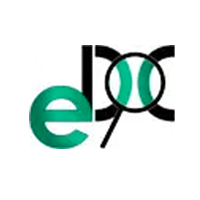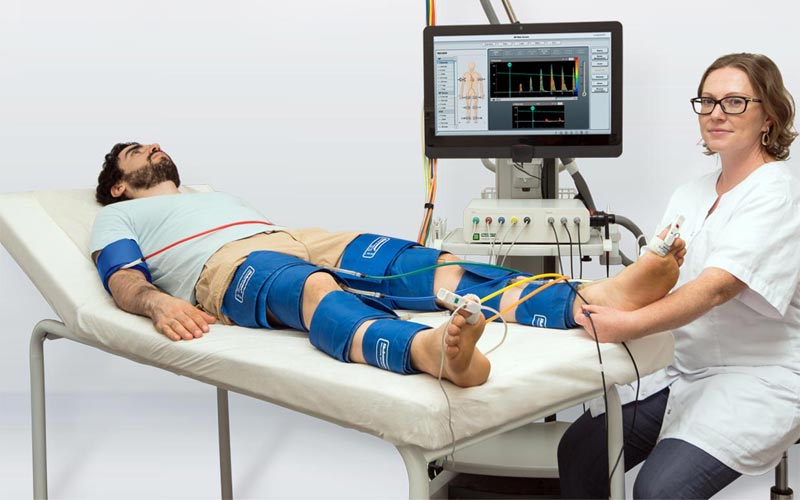
MedTech Edge provides leading peripheral vascular diagnostics in Australia & New Zealand, offering ABI, PVR & Doppler systems for early PAD detection.
Peripheral Artery Disease (PAD) occurs when plaque builds up in the arteries supplying the legs, leading to reduced blood flow and increased cardiovascular risk. This condition is common among older adults but also affects individuals with specific lifestyle and health-related factors. Early warning signs include leg pain during walking, slow-healing wounds on the feet, or numbness and coldness in the lower limbs. Identifying these symptoms early ensures timely referral for further vascular evaluation.
Early diagnosis of PAD depends on reliable vascular testing, which provides clinicians with measurable data beyond physical examination alone. Delayed detection often results in advanced disease requiring surgical intervention, whereas timely screening helps guide conservative treatment strategies. These methods allow practitioners to monitor disease progression and tailor management plans, ultimately reducing the risk of severe complications such as amputation or cardiovascular events.
The value of non-invasive testing in PAD is supported by evidence. The study “Noninvasive physiologic vascular studies: A guide to diagnosing peripheral arterial disease” highlights how physiologic vascular studies such as ABI, Doppler waveforms, and PVR offer reliable insights into arterial function and disease progression (Sibley et al., 2017).
ABI is one of the simplest yet most effective tools in peripheral vascular diagnostics. It compares blood pressure measurements taken at the ankle with those in the arm, providing a reliable indicator of arterial obstruction. Abnormal readings highlight impaired blood flow and support early referral for further imaging.
The main advantages of ABI testing are:
• Non-invasive – Conducted using standard blood pressure cuffs and Doppler probes, with no patient discomfort.
• Quick and efficient – Results are available within minutes, making it suitable for routine screening.
• Reliable baseline tool – Detects early changes in circulation before symptoms escalate.
• Cost-effective – A low-cost method that provides high clinical value in primary care and specialist settings.
PVR testing complements ABI by analysing volume changes in the limb during the cardiac cycle. This approach evaluates the quality of blood flow through waveform interpretation, highlighting arterial narrowing or occlusion. When combined with ABI, PVR enhances diagnostic accuracy, offering clinicians a broader understanding of circulatory health in the lower extremities.
Doppler ultrasound adds a real-time imaging dimension to peripheral vascular diagnostics. Using sound waves to map arterial flow enables clinicians to detect narrowing or blockages with precision. Unlike pressure-based tests, Doppler provides direct visual evidence of the severity and location of disease.
The primary benefits include:
• Real-time imaging – Offers immediate insights into arterial conditions.
• Detailed localisation – Pinpoints the exact site of narrowing or blockage.
• Non-invasive and safe – No radiation or invasive procedure required.
• Supports treatment planning – Informs whether surgical or non-surgical intervention is required.
• Effective for follow-up – Tracks changes in arterial health after treatment or lifestyle modification.
Accurate PAD screening through ABI, PVR, and Doppler ultrasound enables earlier intervention, reducing complications and improving patient outcomes. At MedTech Edge, we provide advanced peripheral vascular diagnostics with Falcon systems that are comprehensive, adaptable, and designed for diverse clinical needs. Our ultramodern non-invasive technologies make vascular screening precise, scalable, and clinically reliable.
Contact us today to enhance your diagnostic service.
Related Blog Article: Pulse Volume Recording (PVR): Improve Non-Invasive PAD Diagnosis with the Falcon
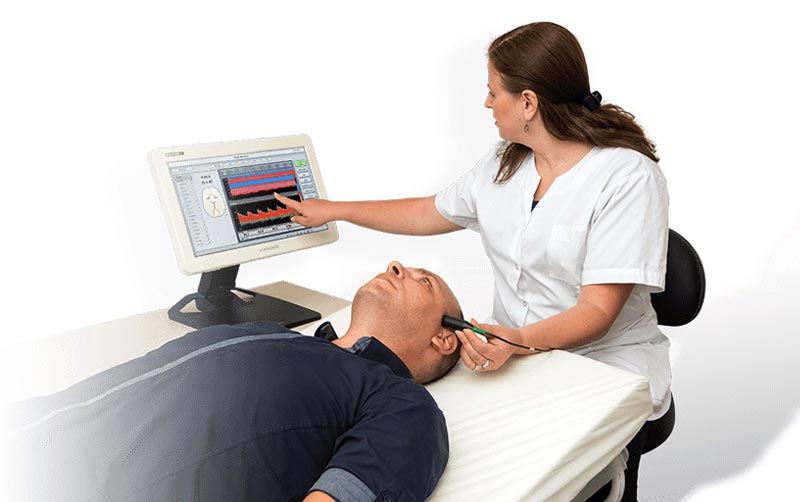
Enhance neurocritical care with MedTech Edge in Australia, offering advanced Transcranial Doppler platforms for timely vasospasm detection in SAH.
Subarachnoid haemorrhage (SAH) represents one of the most severe neurological emergencies, often caused by a ruptured cerebral aneurysm. Among its complications, delayed cerebral ischaemia from vasospasm poses the greatest threat to survival and long-term recovery. Transcranial Doppler has emerged as a reliable, non-invasive tool that allows real-time monitoring of cerebral circulation, enabling early detection of flow changes and timely intervention to prevent irreversible damage.
TCD is an ultrasound-based technique that measures blood flow velocity within the cerebral arteries. Unlike static imaging modalities, it allows dynamic assessment and can be performed repeatedly at the bedside, making it invaluable in intensive care environments.
At MedTech Edge, we offer tailored TCD solutions designed to provide clinicians with clarity, speed, and diagnostic confidence:
• Dolphin Max: Provides high-resolution imaging for detailed analysis of cerebral haemodynamics, supporting precise interpretation of subtle flow changes.
• Dolphin 4D: Delivers four-dimensional imaging for a comprehensive evaluation of intracranial blood flow, offering deeper insights into vascular dynamics.
• Dolphin IQ: Integrates intelligent algorithms that enhance diagnostic accuracy through automated data interpretation, streamlining clinician decision-making.
• Dolphin XF-Robot: Utilises robotic precision to standardise examinations, minimising operator variability and ensuring consistent, reproducible results that improve patient outcomes.
These advanced platforms empower clinicians with tools to detect, monitor, and respond rapidly to vasospasm risk in SAH patients.
While immediate mortality from SAH is a primary concern, survivors face the ongoing risk of cerebral vasospasm. This delayed narrowing of arteries reduces cerebral blood flow and can lead to secondary ischaemic injury. Detecting vasospasm before infarction occurs is essential to improving survival rates and reducing disability.
Transcranial Doppler provides clinicians with an immediate, bedside tool to identify vasospasm before clinical deterioration occurs. This early detection ensures that treatment can begin at the most critical window, reducing the chance of permanent neurological damage. By delivering continuous, real-time data, TCD allows healthcare teams to make evidence-based decisions with greater confidence.
In the review “Transcranial Doppler Monitoring in Subarachnoid Hemorrhage” (J Neurosonol Neuroimag, 2022; 14[1]: 1–9), Park et al. emphasize that TCD enables real-time, bedside detection of cerebral vasospasm and serial monitoring of treatment efficacy in SAH patients. This evidence underscores TCD’s value as a non-invasive, dynamic monitoring tool that enhances timely intervention in neurocritical care settings following subarachnoid haemorrhage.
The integration of TCD into routine neurocritical workflows has transformed SAH monitoring. Its role goes beyond vasospasm detection and contributes to comprehensive patient care:
• Continuous, real-time cerebral flow assessment
• Non-invasive, bedside application
• Guidance for therapy adjustments
• Objective data to support decision-making
• Improved survival and recovery rates
At MedTech Edge, we are committed to delivering innovative Transcranial Doppler solutions that exceed industry standards and integrate seamlessly into routine clinical practice. By enabling early vasospasm detection in subarachnoid haemorrhage, our products empower neurocritical care teams and reflect our vision to provide clinicians with technologies that genuinely improve patient outcomes.
Take the next step in advancing patient care. Contact us at MedTech Edge today to learn how our TCD solutions can support your neurocritical care team.
Related Blog Article: Transcranial Doppler Machines for Sickle Cell Disease – Early Stroke Detection in Children
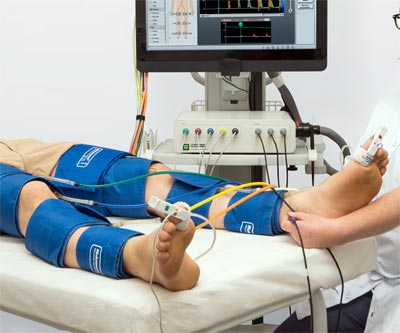
Peripheral vascular disease diagnosis is simplified with Falcon Pro from MedTech Edge, supporting accurate results in Australian and New Zealand clinics.
Peripheral vascular disease diagnosis is increasingly vital in general practices and private clinics across Australia and New Zealand. The condition restricts blood flow to the lower limbs, particularly in ageing populations and people with diabetes, and can cause severe complications if left undetected. MedTech Edge provides the Falcon Pro, an advanced diagnostic system designed to support modern clinics with accurate and timely detection.
Peripheral vascular disease is a condition that narrows or blocks blood vessels, most often in the lower limbs. It commonly affects older adults, smokers, and people living with chronic conditions such as diabetes, reducing blood flow and impacting quality of life.
Typical symptoms include leg pain during walking, numbness, weakness, or cold sensations in the feet. If left undetected, PVD can progress to severe complications such as stroke or limb amputation, making early and reliable screening essential for clinicians.
Despite advances in healthcare, early peripheral vascular disease diagnosis remains a challenge, particularly in smaller practices or regional clinics. Traditional testing methods like manual Ankle-Brachial Index (ABI) or handheld Doppler ultrasound are often time-consuming, require extensive training, and may deliver inconsistent results.
Many clinics face hurdles such as:
• Limited time and staff resources
• Variability in operator skill levels
• Lack of integrated reporting systems
• High equipment and maintenance costs
• Delayed referrals due to uncertain test outcomes
According to the National Center for Biotechnology Information (NCBI), peripheral vascular disease is frequently underdiagnosed and undertreated, increasing the risk of serious complications such as stroke and limb loss. This highlights the need for early peripheral vascular disease diagnosis using reliable in-clinic systems like Falcon Pro.
Falcon Pro, supplied by MedTech Edge, is designed to simplify and automate peripheral vascular disease diagnosis for clinics across Australia and New Zealand. With fast setup and minimal training, healthcare providers can perform advanced vascular assessments in-house while improving patient outcomes.
• Automated ABI and TBI testing: Provides accurate ankle-brachial and toe-brachial index measurements to detect peripheral artery disease at an early stage.
• Doppler ultrasound and PPG testing: Combines sound-wave and photoplethysmography technology for precise vascular flow analysis.
• Real-time Pulse Volume Recording (PVR): Delivers instant waveform data to assess blood flow and arterial health.
• Segmental pressure and stress testing: Identifies blockages and circulation issues in specific limb segments under different conditions.
• Seamless EMR and PACS integration: Connects easily with clinical systems for efficient reporting, data storage, and patient management.
Early detection of peripheral vascular disease is essential to reducing life-altering risks such as stroke, limb loss, and long-term disability. With Falcon Pro, supplied by MedTech Edge, clinics in Australia and New Zealand gain a reliable tool for accurate and timely vascular assessment. This streamlined approach empowers healthcare providers to deliver better outcomes and stronger long-term patient care.
Contact us today to learn how Falcon Pro can elevate your clinic’s vascular diagnostic capabilities.
Related Blog Article: Falcon Pro PPG Technology: Enhancing Vascular Health Monitoring for Clinics
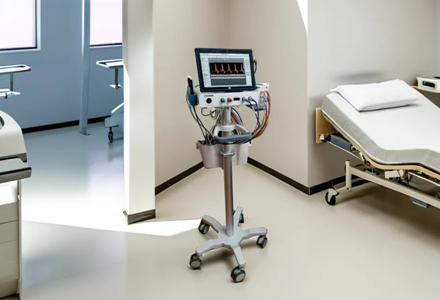
MedTech Edge offers non-invasive medical diagnostic equipment across Australia, built for precise DVT detection, clinical workflow efficiency, and speed.
Deep Vein Thrombosis (DVT) poses a serious risk to patient health, particularly when clots remain undetected and lead to complications such as pulmonary embolism. Accurate peripheral vascular diagnosis requires high-performance medical diagnostic equipment that supports early detection and informed clinical decisions. MedTech Edge delivers advanced solutions that help healthcare professionals identify DVT with precision and reliability.
Deep Vein Thrombosis (DVT) refers to the formation of a blood clot within a deep vein, most commonly in the lower extremities such as the calf or thigh. When dislodged, the clot can travel to the lungs and cause a pulmonary embolism, an acute, potentially fatal event requiring urgent intervention.
Clinical symptoms may include swelling, tenderness, localised warmth, or discolouration of the affected limb, though many cases remain asymptomatic. As noted in recent studies from the National Library of Medicine on Deep Vein Thrombosis: Diagnosis of a Comon Clinical Problem, the diagnosis of DVT is often challenging because the clinical symptoms and signs are nonspecific. This further highlights the need for precise vascular tools that support early identification and accurate peripheral vascular diagnosis.
Selecting the right technology for peripheral vascular assessments requires more than just basic functionality. The most effective diagnostic tools for Deep Vein Thrombosis combine clinical precision, efficiency, and system integration to support accurate, real-time decision-making.
Below are essential features that define high-performing vascular diagnostic equipment:
• High Diagnostic Accuracy: Delivers sensitive and specific results to detect even subtle abnormalities in venous flow, reducing the risk of misdiagnosis or delayed treatment.
• Real-Time Waveform Output: Enables immediate visualisation of vascular signals, providing clinicians with the actionable data needed for on-the-spot interpretation and decision-making.
• Compact and Portable Design: Facilitates bedside assessments, mobile diagnostics, and flexible deployment across clinical settings without compromising performance.
• Intuitive User Interface: Streamlines clinical workflows with easy-to-navigate controls, reducing setup time and supporting consistency in multi-user environments.
• Electronic Health Record (EHR) Integration: Ensures secure and efficient transfer of diagnostic data into patient records, improving documentation accuracy and compliance with clinical protocols.
MedTech Edge offers a curated selection of medical diagnostic equipment systems that balance clinical precision with everyday practicality. Our non-invasive solutions are advanced, versatile, and customisable, designed to meet the unique demands of modern peripheral vascular diagnosis.
Our standout peripheral vascular diagnosis machines include:
• Falcon Pro: A complete vascular physiologic diagnostic system designed for comprehensive peripheral assessments.
• Falcon Quad: A powerful 4-channel ABI system built for efficient and accurate vascular evaluations.
• Falcon Xpress: Lightweight (1.25 kg), battery-operated unit featuring integrated IR receiver, USB isolation, and VESA mountability for mobile diagnostic use.
Reliable medical diagnostic equipment supports early, accurate detection of conditions like DVT and helps streamline everyday clinical workflows. At MedTech Edge, we offer tailored solutions that combine performance, ease of use, and clinical confidence.
Let’s help you find the system that fits your clinic best. Contact us at MedTech Edge to find the right fit for your vascular diagnostic needs.
Related Blog: Peripheral Vascular Diagnostic Equipment: Advancing Early Peripheral Arterial Disease Diagnosis
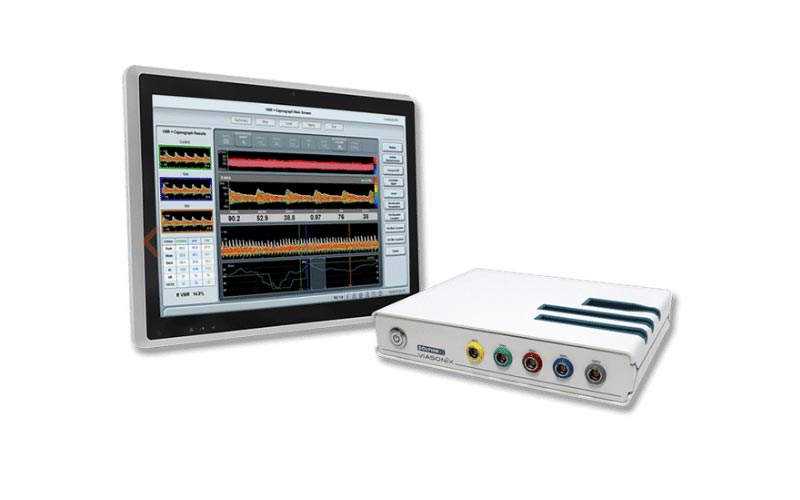
Doppler ultrasound machines for intracranial hypertension from MedTech Edge offer expert neurovascular support and innovation for Australian clinicians.
Intracranial hypertension is a critical neurological condition that requires immediate and precise intervention to prevent serious complications. At MedTech Edge, we proudly offer state-of-the-art Doppler ultrasound machines for advanced neurovascular assessment. Our Doppler ultrasound technology provides rapid, non-invasive insights that clinicians need to support patients with suspected or confirmed intracranial hypertension, setting a new benchmark in neurocritical care.
Intracranial hypertension is defined by an abnormal increase in pressure within the skull, often due to trauma, haemorrhage, tumours, or brain swelling. If left unchecked, raised intracranial pressure (ICP) can quickly lead to brain tissue damage or life-threatening complications. Modern transcranial Doppler systems play a crucial role in non-invasive monitoring of intracranial pressure.
These advanced neurovascular imaging devices allow clinicians to visualise cerebral blood flow and assess vascular resistance efficiently. Doppler ultrasonography provides detailed data on blood flow velocity and direction in major brain arteries. This technology enables healthcare professionals to detect subtle changes in cerebral perfusion early, allowing for timely intervention and better patient outcomes.
See how our transcranial Dopplers can elevate your neurovascular support.
The use of Doppler-based ultrasonography in managing intracranial hypertension brings multiple clinical advantages, including:
• Continuous cerebral blood flow monitoring: Gain real-time data to identify and respond to fluctuations in perfusion.
• Assessment of vascular resistance: Evaluate resistance indices to determine the severity of increased intracranial pressure.
• Early detection of vasospasm or arterial narrowing: Detect complications such as vasospasm following subarachnoid haemorrhage for faster intervention.
• Identifying at-risk patients: Screen and monitor patients prone to secondary brain injuries, improving overall outcomes.
• Therapy monitoring: Evaluate the effectiveness of interventions aimed at lowering intracranial pressure, from medical therapies to surgical procedures.
Doppler ultrasound offers valuable advantages in neurovascular monitoring, but several important considerations can help maximise its clinical utility. Operator experience is an important factor, as skill and technique play a role in achieving accurate transcranial Doppler (TCD) measurements. In some patients, acoustic windows may vary, and selecting the optimal site for ultrasound penetration ensures reliable data.
For comprehensive neurovascular assessment, TCD is best used alongside other imaging modalities such as CT or MRI, allowing for a well-rounded understanding of both functional and anatomical details. Technical factors such as careful probe placement, calibration, and attention to patient positioning further enhance measurement consistency. In cases involving significant cerebral swelling or unique skull anatomy, clinicians may choose to supplement TCD with alternative approaches, ensuring thorough evaluation and optimal patient outcomes.
For more in-depth scientific discussion, see Mekonnen, H. et al., “The Use of Transcranial Doppler in the Assessment of Intracranial Pressure,” PMC7310456, 2020.
At MedTech Edge, we are your trusted partner for innovative Doppler ultrasound machines, designed to provide rapid, real-time, and non-invasive cerebrovascular assessment. We support clinicians with advanced technology that meets and exceeds the expectations of modern clinical practice. Whether referred to as transcranial Doppler systems, neurovascular imaging devices, or cerebrovascular ultrasound units, our solutions deliver reliable performance and efficiency in demanding neurocritical care environments.
Contact us at MedTech Edge for expert support, the latest medical technology, and ongoing insights to keep your clinical team at the forefront of patient care.
Beyond intracranial hypertension, explore how Doppler ultrasound machines impact neurology and cardiovascular care: Doppler Ultrasound Applications in Neurology and Cardiovascular Care.


